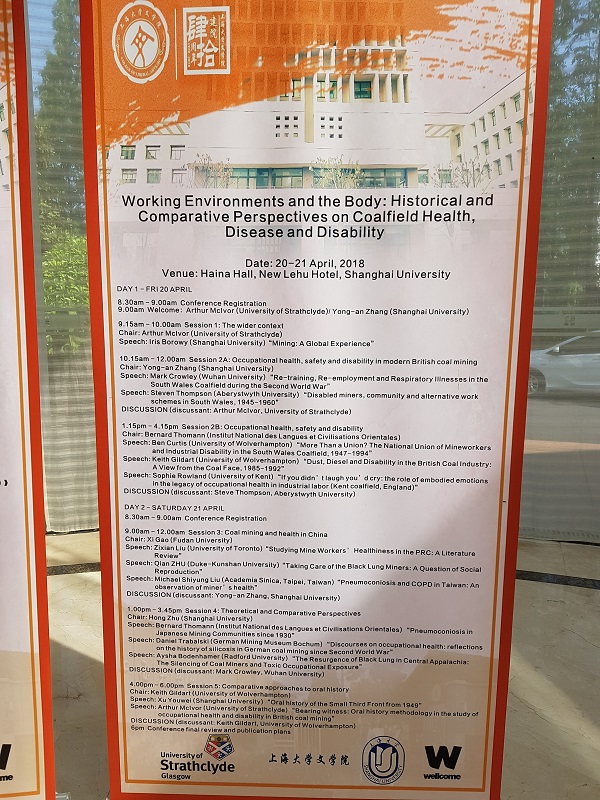
Attending the ‘Working Environments and the Body’ conference, Shanghai, China, April 2018
In April 2018 two members of the project team – Professor Keith Gildart and Dr Ben Curtis – travelled to Shanghai to participate in a conference entitled ‘Working Environments and the Body: Historical and Comparative Perspectives on Coalfield Health, Disease and Disability’. The conference was co-organised by the Centre for the Social History of Health and Health Care, University of Strathclyde and the David P. Musto Center for Drug Policy Studies, Shanghai University, with their principal representatives being Professor Arthur McIvor and Professor Yong-an Zhang respectively. It was sponsored by the Wellcome Trust.

The conference provided a fascinating opportunity for academics from around the world to discuss the many deleterious ways in which mining has impacted upon miners’ bodies and mining communities, as well as the various attempts to ameliorate working and living conditions. Although the historical element of this was the focus of most of the presentations, particularly from UK conference attendees, sociologists studying present-day mining communities in China and Appalachia in the USA emphasised the ways in which these issues continue to impact upon miners’ lives down to the present day. For the project’s representatives, it was illuminating and insightful to meet with other experts in the field of mining history and reflect upon areas of similarity and contrast across time and place. Industrial disability history has increasingly become recognised as an important focus of historiographical attention by scholars over the last decade or so – and on the evidence of the quality of the material presented at this conference, this looks certain to continue for the foreseeable future.
Professor Gildart’s presentation was entitled ‘Dust, Diesel and Disability in the British Coal Industry: A View from the Coal Face, 1985–1992’. In it, he drew extensively on his experiences of underground work as a mineworker at Point of Ayr Colliery in the North Wales coalfield, as well as his time as a health-and-safety representative for the Point of Ayr branch of the National Union of Mineworkers (NUM). Professor Gildart located his experiences within the broader historical context of mining in that coalfield in the later twentieth century, before concluding by reflecting upon the legacy of the demise of the industry and its impact upon miners’ bodies and communities in North Wales.

In his presentation, entitled ‘More Than a Union? The National Union of Mineworkers South Wales Area and Industrial Disability in the South Wales Coalfield, 1947–1994’, Dr Curtis used a mixture of archival and oral-history sources to discuss the many and various ways in which the NUM’s South Wales Area worked to assist its disabled members during this period, including: campaigning, protest actions, representation, and provision of rehabilitation and convalescence facilities. In his paper, he sought to develop and provide further historical substantiation for the idea that the South Wales Area NUM did indeed play a prominent role in addressing industrial disability issues in that coalfield.

The conference took place over two busy days filled with discussion and debate. In the day afterwards, conference delegates were able to spend a memorable day looking around the centre of Shanghai, one of the biggest and most dynamic cities in the world.
For more information please contact the Corporate Communications Team.


/prod01/wlvacuk/media/departments/digital-content-and-communications/images-2024/240328-Varsity-Line-Up-Resized.jpg)
/prod01/wlvacuk/media/departments/digital-content-and-communications/images-18-19/220325-Engineers_teach_thumbail.jpg)
/prod01/wlvacuk/media/departments/digital-content-and-communications/images-2024/240404-Digital-Humanities-Training-Resized.jpg)
/prod01/wlvacuk/media/departments/digital-content-and-communications/images-2024/240320-Uzbekistan-Resized.jpg)
/prod01/wlvacuk/media/departments/digital-content-and-communications/images-2024/240229-The-Link-Resized.jpg)
/prod01/wlvacuk/media/departments/digital-content-and-communications/images-2024/240404-Pharmacy-Students-Resized.jpg)